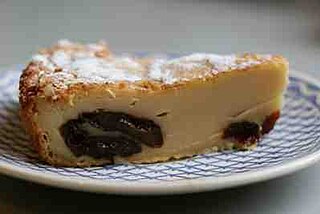 W
WThis is a list of plum dishes. Plum dishes are those that use plums or prunes as a primary ingredient. Some plum dishes also use other fruits in their preparation. Plum and prune snack foods and beverages are also included in this list.
 W
WChocolate-covered prunes, also known as plums in chocolate or prunes in chocolate are a kind of sweet; a chocolate candy with an entire dried plum as a filling.
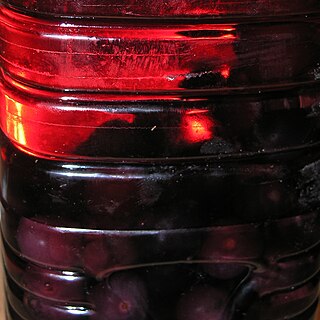 W
WDamson gin is a liqueur, usually homemade, made from damson plums macerated in a sugar and gin syrup for eight weeks or more. Vodka is sometimes used in place of the gin. The proof will vary somewhat but generally is around 44.
 W
WGermknödel is a fluffy yeast dough dumpling (knödel), filled with spiced plum jam and served with melted butter and a mix of poppy seeds and sugar on top. It is occasionally - even though less traditional - served with vanilla cream sauce instead. It is a culinary specialty of Austria and Bavaria. The dish is served both as a dessert and as a main course.
 W
WHitlerszalonna or Hitler-szalonna was a dense fruit jam, although there is debate about how much fruit was actually in it and how edible it was, that was eaten by Hungarian troops and civilians during World War II. It was made from mixed fruits such as plum and sold in brick shaped blocks held in a piece of paper rather than in a jar. These slabs were sliced, a bit like szalonna. Soldiers kept it in a case and it could be cooked with other foods. The term itself is considered slang and defined as something like "tough fruit".
 W
WA joulutorttu is a Finnish Christmas pastry. It is traditionally made from puff pastry in the shape of a star or pinwheel and filled with prune jam and often dusted with icing sugar. The pastries can be in other shapes and apple used in place of the prune jam.
 W
WKnedle, is a dish of boiled potato-dough dumplings filled with plums or apricots, popular in Central and East European countries, especially in Poland, Hungary, Serbia, Croatia, Bosnia-Herzegovina, Romania, Slovakia and Czech Republic. The dish is eaten as dessert, a main dish, or side dish.
 W
WOlho de sogra is a Brazilian candy, consisting of a beijinho candy inside a dried plum. The final mix is rolled over crystal sugar. The name comes from the shape of the candy, which resembles an eye.
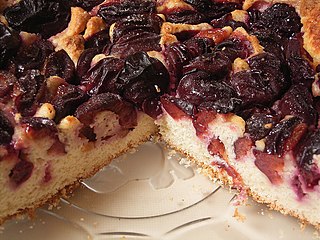 W
WPlum cake refers to a wide range of cakes made with either dried fruit or with fresh fruit. There is a wide range of popular plum cakes and puddings. Since the meaning of the word "plum" has changed over time, many items referred to as plum cakes and popular in England since at least the eighteenth century have now become known as fruitcake. The English variety of plum cake also exists on the European mainland, but may vary in ingredients and consistency. Settlers in British colonies brought the dried fruit variety of cake with them, so that for example, in India it was served around the time of the Christmas holiday season and in the American colonies, where it became associated with elections, one version came to be called election cake.
 W
WPlum sauce is a viscous, light brown sweet and sour condiment. It is used in Cantonese cuisine as a dip for deep-fried dishes, such as spring rolls, noodles, and deep-fried chicken balls as well as for roast duck. It is made from sweet plums or other fruit such as peach, pineapple or apricot, along with sugar, vinegar, salt, ginger and chili peppers.
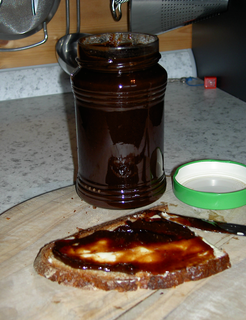 W
WPowidl is a fruit spread prepared from the zwetschge plum. Unlike jam or marmalade, and unlike the German Pflaumenmus, powidl is prepared without additional sweeteners or gelling agents.
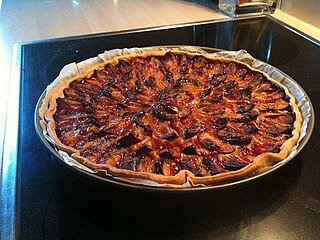 W
WQuetschentaart, a popular Luxemburg speciality, is a simple open fruit tart with the local type of plum, Prunus domestica L. subsp. italica, closest to a damson or zwetschge, which do not give off much water. It does not work with more watery types of plums, and the stone must be easily removable too.
 W
WSloe gin is a British red liqueur made with gin and sloes. Sloes are the fruit (drupe) of Prunus spinosa, a relative of the plum. Sloe gin has an alcohol content between 15 and 30 percent by volume. However, the European Union has established a minimum of 25% ABV for sloe gin to be named as such. Sloe gin is technically a gin-based liqueur, but due to historical prevalence at the time of writing the EU spirit drink regulations the colloquial name 'sloe gin' was included in the legal definitions and as such is the only gin-based liqueur that can legally be called gin without the liqueur suffix. The traditional way of making sloe gin is to soak the sloes in gin. Sugar is required to ensure the sloe juice is extracted from the fruit.
 W
WSmoked plum is the smoked fruit of Asian plums, used in East Asian cuisine and medicine. It is called wūméi (烏梅) in Mandarin, omae in Korean, and ubai in Japanese.
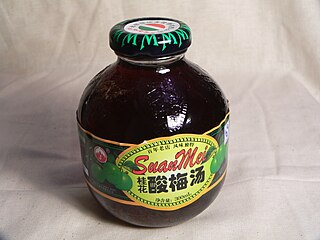 W
WSuanmeitang or sour prune drink is a traditional Chinese beverage made from smoked plums, rock sugar, and other ingredients such as sweet osmanthus. Due to the sour plums used in its production, suanmeitang is slightly salty in addition to being sweet and rather sour.
 W
WTkemali is a Georgian sauce primarily made of cherry plum, sometimes alucha or other varieties of plum. Both red and green varieties of plum are used. The flavor of the sauce varies, but generally tends to be pungently tart. To lower the tartness level, occasionally sweeter types of plums are added during preparation. Traditionally, besides plum the following ingredients are used: garlic, pennyroyal, cumin, coriander, dill, chili pepper and salt.
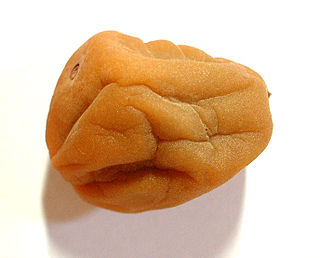 W
WUmeboshi are pickled (brined) ume fruits common in Japan. The word umeboshi is often translated into English as 'salted Japanese plums', 'Japanese plums' or 'preserved plums'. Ume is a species of fruit-bearing tree in the genus Prunus, which is often called a "plum", but is actually more closely related to the apricot. Pickled ume which are not dried are also called umezuke (梅漬け).
 W
WUmeshu (梅酒) is a Japanese liqueur made by steeping ume plums in liquor and sugar. It has a sweet, sour taste, and an alcohol content of 10–15%. Famous brands of umeshu include Choya, Takara Shuzo and Matsuyuki. Varieties are available with whole ume fruits contained in the bottle, and some people make their own umeshu at home.
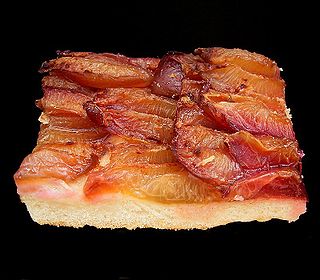 W
WZwetschgenkuchen, Pflaumenkuchen or Zwetschgendatschi is a sheet cake or pie made from yeast dough or shortcrust dough that is thinly spread onto a baking sheet or other baking mold and covered with pitted zwetschgen plums. It is popular as a summer cake and has different local labelings throughout Germany, Austria and Switzerland.